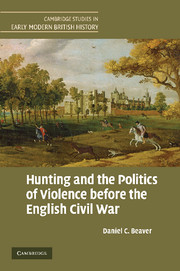Book contents
- Frontmatter
- Contents
- List of maps
- Acknowledgments
- List of abbreviations
- Introduction: Hunting, violence, and the origins of the English Revolution
- 1 Blood, sacrifice, and order: meanings of the forest and hunt in culture, politics, and society
- 2 Honor, property, and the symbolism of the hunt in Stowe, 1590–1642
- 3 Ancient liberties and the politics of the commonweal in Waltham Forest, 1608–1642
- 4 Royal honor, great parks, and the commonweal in Windsor Forest, 1603–1642
- 5 Venison and the politics of honor in Corse Lawn Chase, 1620–1642
- Conclusion: Royal symbols, forest politics, and popular politics in early modern England
- Bibliography
- Index
- Titles in the series
Introduction: Hunting, violence, and the origins of the English Revolution
Published online by Cambridge University Press: 06 March 2010
- Frontmatter
- Contents
- List of maps
- Acknowledgments
- List of abbreviations
- Introduction: Hunting, violence, and the origins of the English Revolution
- 1 Blood, sacrifice, and order: meanings of the forest and hunt in culture, politics, and society
- 2 Honor, property, and the symbolism of the hunt in Stowe, 1590–1642
- 3 Ancient liberties and the politics of the commonweal in Waltham Forest, 1608–1642
- 4 Royal honor, great parks, and the commonweal in Windsor Forest, 1603–1642
- 5 Venison and the politics of honor in Corse Lawn Chase, 1620–1642
- Conclusion: Royal symbols, forest politics, and popular politics in early modern England
- Bibliography
- Index
- Titles in the series
Summary
You go down new streets, you see houses you never saw before, pass places you never knew were there. Everything changes … Sometimes it changes even if you go the same way.
Samuel R. Delany, Dhalgren (1974)This book is about the series of attacks on parks, chases, and forests in southern England during the late spring and summer of 1642. It is also about the words used to define the meanings of the attacks and about how these words were weighted with the histories of the places where the attacks occurred. Many of those who killed deer or cut down woods during this summer of violence justified their actions as a defense of high principles, claiming the moral authority of law and commonwealth. Their words evoked the long histories of communities embedded in the royal forests or perched on the margins of forests, those great hunting preserves of the English crown and nobility. As early as October 1641, neighbors on the southeastern border of Windsor Forest had justified attacks on the king's deer as a defense of their “ancient customs” and the status of their lands as liberty of purlieu rather than forest, and these attacks continued in the following year. In late April 1642, hunters in Waltham Forest cited the limits of settled law as a defense for killing deer. This book tells the political histories that lay behind this choice of words and actions in 1642.
- Type
- Chapter
- Information
- Publisher: Cambridge University PressPrint publication year: 2008



